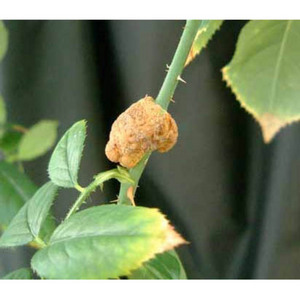Jun. 20, 2008 Research Highlight Biology
Sights set on plant tumor trigger
New insight into how a key enzyme causes plant tumors could ultimately reduce crop losses
 Figure 1: A crown gall (tumor) caused by Agrobacterium infection.
Figure 1: A crown gall (tumor) caused by Agrobacterium infection.
Researchers at RIKEN’s Plant Science Center in Yokohama have unraveled the structure, molecular operation and evolution of a key enzyme in the bacterial production of the plant growth hormones known as cytokinins. The work is important because bacterially produced cytokinins can trigger tumors (Fig. 1), which cause significant crop losses. The findings may be used to design plant growth regulators and to stop bacteria from generating tumors.
A critical step in synthesizing cytokinins is prenylation. The enzymes which control prenylation are called adenosine phosphate-isopentyltransferases (IPTs). From previous work it is known that the IPTs of plants and of bacteria, although catalyzing the same reaction, are structurally very different. Bacterial IPTs are more efficient and versatile in that they can use two different compounds as donors of the prenyl molecular group—one of which is hijacked from the plants they attack—whereas plants use only one.
In a recent paper published in the Proceedings of the National Academy of Sciences 1, the researchers detail how, using x-ray crystallography, they determined the structure of Tzs, an IPT of the important plant pathogen Agrobacterium tumefaciens. By solving four structures of Tzs bound to compounds or their analogues involved in prenylation, the researchers were able to uncover the reaction site of the enzyme and a probable mechanism.
They then substituted individual amino acids in the enzyme protein chain at the reaction site and discovered two specific amino acids were crucial to the catalyst’s ability to use different donor compounds. The reaction involves an amino acid sequence known as a p loop, used in sulfate or phosphate transfer in many other enzymes.
Interestingly, however, when the researchers compared the proteins’ structures with others in an electronic database, they found that, while it closely resembled a superfamily of p loop-containing enzymes, the bacterial IPT is the sole known example of p loop involvement in prenylation. They suggest the enzymes evolved from a common ancestor.
“The reaction center is very, very similar, but the function of the p loop is different between the IPT and the other enzymes,” says project-leader Hitoshi Sakakibara. “Now, by modifying Agrobacterium genes, we are trying to find out why the bacteria use the second prenyl donor. Eventually, we hope to develop something to block bacterial cytokinin formation and reduce economic loss.”
References
- 1. Sugawara, H., Ueda, N., Kojima, M., Makita, N., Yamaya, T. & Sakakibara, H. Structural insight into the reaction mechanism and evolution of cytokinin biosynthesis. Proceedings of the National Academy of Sciences USA 105, 2734–2739 (2008). doi: 10.1073/pnas.0707374105
